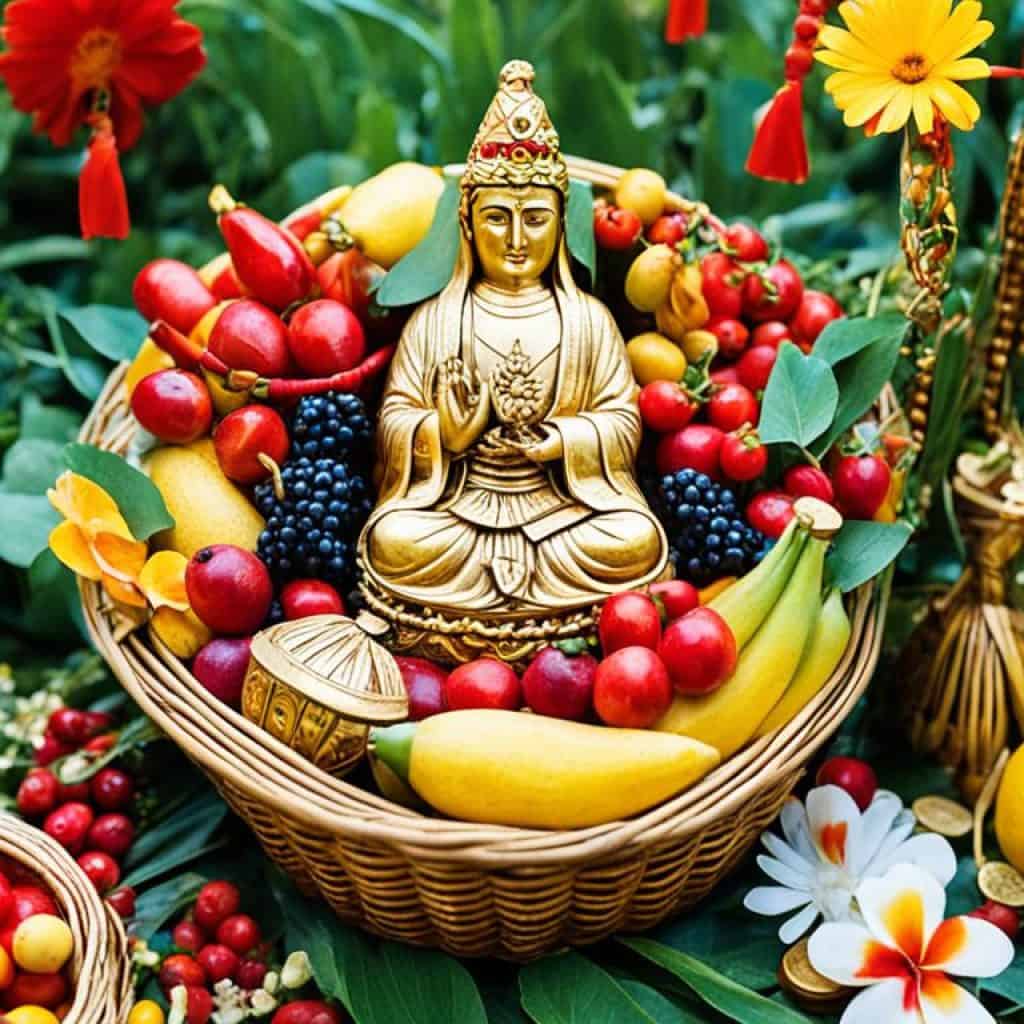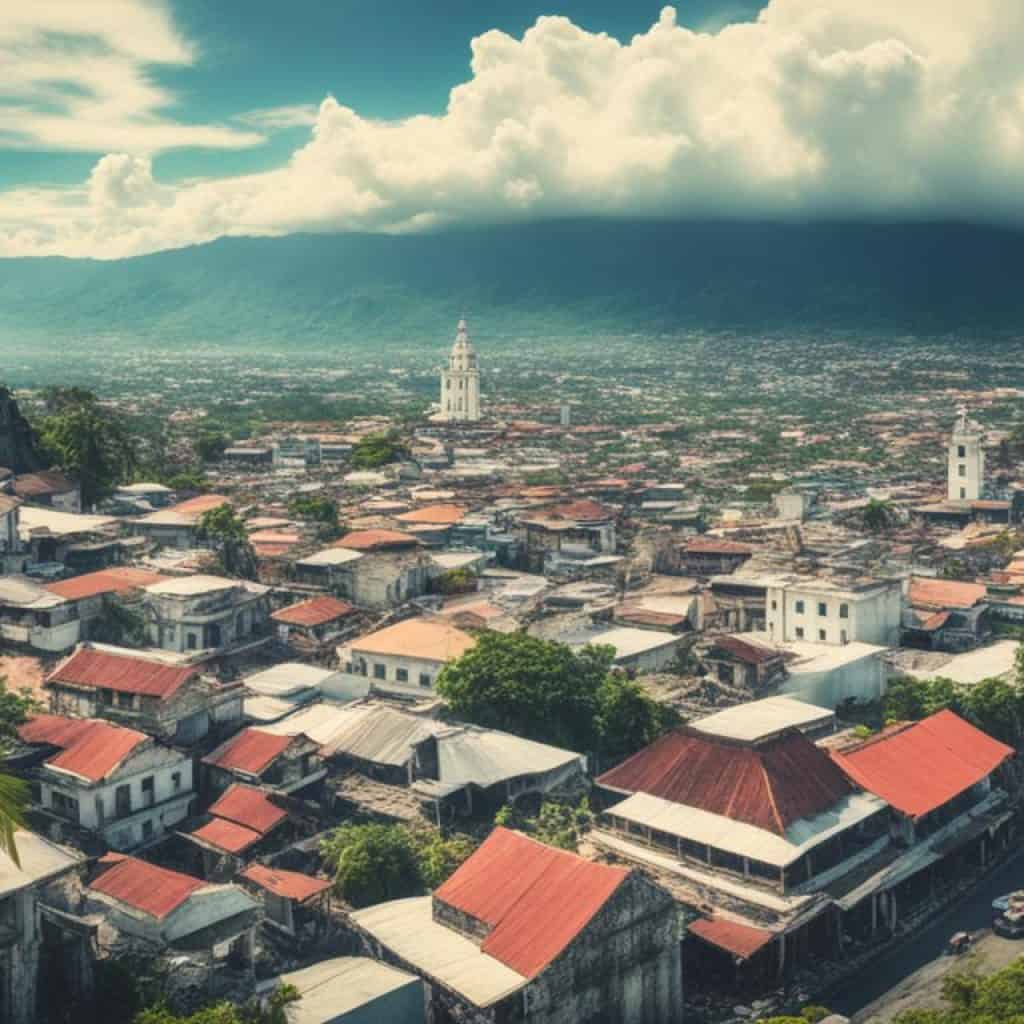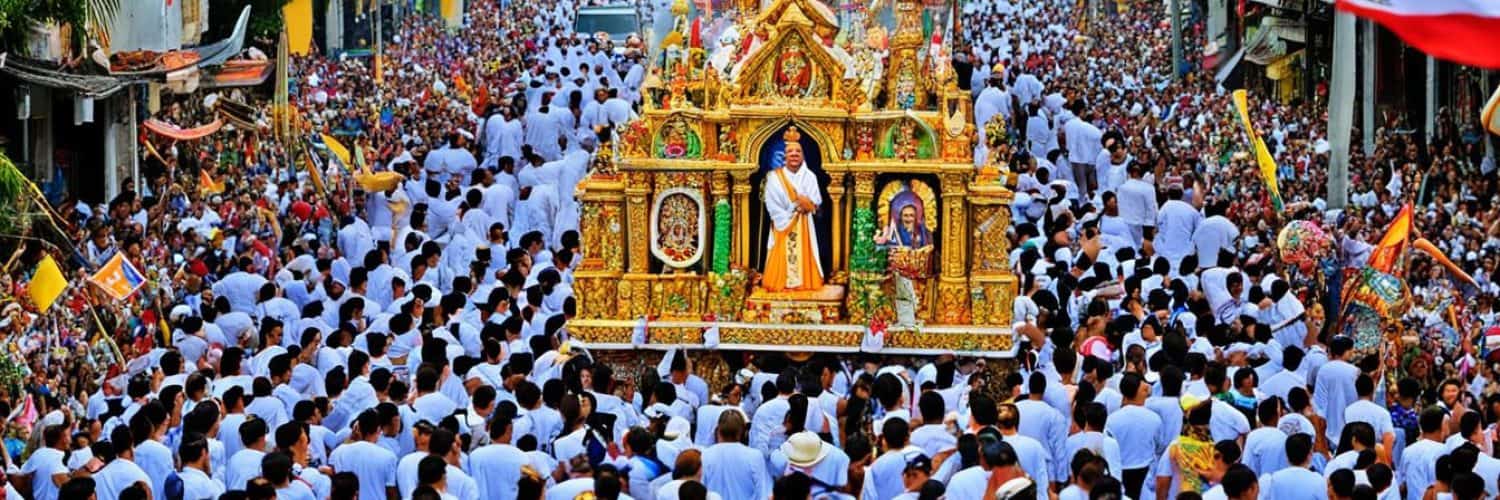Have you ever wondered about the diverse religious traditions and beliefs in Cebu City? This vibrant city in the Philippines has a rich tapestry of faith that is deeply rooted in Spanish culture, influenced by American customs, and still holds strong to its Filipino identity. From birth to death, the Cebuanos observe various customs and traditions steeped in religious significance. But what exactly are these customs, and how do they shape the lives of the people in Cebu?
Key Takeaways:
- Religion plays a significant role in the lives of the Cebuanos, shaping their customs and traditions.
- Cebu City is known for its historical churches, religious landmarks, and vibrant spiritual festivals.
- The Cebuanos’ religious practices reflect a blend of Spanish, American, and Filipino influences.
- From birth to death, various ceremonies and rituals are observed by the Cebuanos, showcasing their strong belief in Christianity.
- Exploring the religious traditions and beliefs in Cebu gives us a deeper understanding of the city’s cultural tapestry.
Customs and Traditions of the Cebuanos
The Cebuanos have a rich tapestry of customs and traditions that reflect their strong cultural identity and deep-rooted beliefs. From childbirth to marriage and spiritual practices, their customs are embedded in their everyday lives.
Birthing Rituals and Beliefs
During childbirth, Cebuanos follow unique rituals to protect the mother and child. They believe that placing pomelo leaves under the house wards off evil spirits, ensuring a safe delivery. Additionally, burning dried leaves and roots during labor is thought to alleviate pain and assist in the birthing process.
Marital Customs and Symbolic Rituals
In Cebuano weddings, the groom traditionally covers all expenses of the after-party, highlighting his responsibility to provide for the new family. Another symbolic ritual involves the newlyweds participating in a water and leaves ceremony, signifying harmony and unity in their married life.
Pre-Hispanic Beliefs and Offerings
Before the arrival of the Spaniards, pre-Hispanic Filipinos believed in Bathala (Supreme Being) and Diwatas (deities). Cebuanos continue to honor these traditions by offering pusô, a type of rice dish, to diwatas during festivals and activities, paying homage to their ancestral beliefs.
“The Cebuanos’ customs and traditions are deeply intertwined with their everyday lives and reflect their rich cultural heritage.”
Strong Christian Beliefs
The Cebuanos’ strong belief in Christianity is evident in their customs and traditions. The annual God’s Armada fluvial procession is a grand showcase of their devotion, as hundreds of sea vessels participate in this religious event, highlighting their faith and unwavering commitment to their Christianity.
Through their customs and traditions, the Cebuanos preserve their unique cultural identity and honor their ancestors’ beliefs. These practices and rituals continue to shape the vibrant Cebuano culture and enrich the lives of its people.
Religious and Historical Landmarks of Cebu
Cebu is renowned for its religious and historical landmarks, which showcase the architectural beauty and deep religious significance of the city. Among these landmarks are the Basilica Minore del Santo Niño and Nuestra Señora del Patrocinio Church.
The Basilica Minore del Santo Niño, the oldest Roman Catholic church in the Philippines, holds great religious importance. It houses the revered image of the Santo Niño de Cebú, a cherished religious icon venerated by millions of Filipinos.
Nuestra Señora del Patrocinio Church is not just a place of worship but also a testament to Cebu’s historical resilience. This church served as a fortress, providing shelter and protection during pirate sieges that threatened the city.
These religious landmarks are not only architectural marvels but also sacred spaces where believers gather to express their devotion and faith.
Spiritual Festivals in Cebu
Cebu City is renowned for its vibrant spiritual festivals, showcasing the deep-rooted faith of the Cebuanos. Among these festivals, the Sinulog Festival and the God’s Armada stand out as grand celebrations that attract both locals and tourists.
Sinulog Festival
The Sinulog Festival, held annually in January, is a remarkable tribute to the Santo Niño de Cebu. This religious event brings together thousands of devotees who participate in colorful processions, street dances, and cultural performances. The festival’s main highlight is the Sinulog Grand Parade, where contingents wearing traditional costumes and vibrant headdresses showcase their awe-inspiring choreography. The joyful atmosphere, pulsating beats of drums, and fervent chants create an unforgettable experience for all.
God’s Armada
Another significant spiritual festival in Cebu is the God’s Armada, known for its mesmerizing fluvial procession. During this event, hundreds of sea vessels fill the majestic Mactan Channel, sailing alongside the iconic Magellan’s Cross and the Basilica Minore del Santo Niño. This solemn yet awe-inspiring spectacle pays homage to the city’s Christian heritage and reflects the strong faith of the Cebuanos. The mesmerizing display of lights and the blending of religious rituals with marine elements make the God’s Armada an extraordinary experience.
“The Sinulog Festival and the God’s Armada are vibrant spiritual festivals that showcase the deep-rooted faith of the Cebuanos.”
Whether you participate in the exuberant Sinulog Festival or witness the grandeur of the God’s Armada, these spiritual festivals offer an immersive experience into the religious traditions and cultural heritage of Cebu. The colorful festivities, devotion, and unity displayed during these celebrations make them an integral part of Cebuano identity.
| Festival | Date | Highlights |
|---|---|---|
| Sinulog Festival | January | Colorful processions, street dances, and cultural performances |
| God’s Armada | Various dates | Fluvial procession with hundreds of sea vessels |
Southern Cebu Jubilee Churches Tour
For those interested in exploring the rich religious history of Cebu, the Southern Cebu Jubilee Churches Tour, organized by the Department of Tourism, offers a captivating journey through the scenic landscapes and historic churches of Southern Cebu. This guided tour allows visitors to immerse themselves in the spiritual heritage of the region and witness the architectural marvels that have withstood the test of time.
The tour features visits to several jubilee churches, including the renowned Basilica Minore del Santo Niño. This historic church, located in Cebu City, is not only a significant pilgrimage site but also a testament to the enduring faith of the Filipino people. As the oldest Roman Catholic church in the Philippines, it holds the revered image of Santo Niño de Cebú, a symbol of devotion and spirituality.
Another remarkable stop on the tour is the St. Catherine of Alexandria Church in Carcar. This beautiful church, known for its intricate carvings and neoclassical architecture, is a true testament to the craftsmanship and artistry of the Cebuanos. Visitors can witness its grandeur and immerse themselves in its sacred ambiance.
Argao’s St. Michael the Archangel Parish is another must-visit destination, renowned for its rich history and cultural significance. This Spanish colonial-era church showcases a fascinating blend of European and local architectural styles, reflecting the cultural influences of the time.
The Southern Cebu Jubilee Churches Tour offers an opportunity to delve into the religious and historical heritage of Cebu, allowing visitors to experience the spiritual sanctuaries that have played a vital role in shaping the faith of the Cebuano people.
| Church | Location | Features |
|---|---|---|
| Basilica Minore del Santo Niño | Cebu City | Oldest Roman Catholic church in the Philippines, houses the image of Santo Niño de Cebú |
| St. Catherine of Alexandria Church | Carcar | Intricate carvings, neoclassical architecture |
| St. Michael the Archangel Parish | Argao | Spanish colonial-era church, blend of European and local architectural styles |
Marian Pilgrimage of Metro Cebu
For those who have a devotion to the Blessed Virgin, the Department of Tourism offers the Marian Pilgrimage of Metro Cebu. This pilgrimage tour allows visitors to immerse themselves in the spiritual heritage of the city by visiting four churches dedicated to the Blessed Virgin. Among the notable churches included in the tour are Our Lady of Guadalupe de Cebu, known for its revered image of the Virgin Mary, and the Archdiocesan Shrine of Our Lady of Lourdes, a site of pilgrimage and prayer.
Embarking on the Marian Pilgrimage of Metro Cebu is a chance to deepen one’s faith and experience the religious significance of these sacred places. The tour provides a glimpse into the profound devotion Cebuanos have for the Blessed Virgin Mary and offers participants an opportunity for reflection and prayer.
Join the pilgrimage and discover the spiritual richness of Metro Cebu, where faith and devotion to the Blessed Virgin are deeply ingrained in the hearts of the local community.
| Church | Location |
|---|---|
| Our Lady of Guadalupe de Cebu | Cebu City |
| Archdiocesan Shrine of Our Lady of Lourdes | Cebu City |
| Church 3 | Location 3 |
| Church 4 | Location 4 |
Cebuano Superstitious Beliefs and Traditions
Superstitions and traditions have always been an integral part of the Cebuano culture. These beliefs, passed down from generation to generation, add a touch of mystery and intrigue to daily life in Cebu. Let’s explore some of the fascinating superstitious beliefs and customs practiced by the Cebuanos.
1. Staircase Superstition
Cebuanos believe that the number of stairs in a house should not be divisible by three. It is said that having a number like 9, 12, or 15 stairs brings bad luck. To avoid any misfortune, they make sure to have an odd number of stairs, such as 10 or 13.
2. Lucky Wallets
Giving a wallet as a gift is considered lucky in Cebuano culture, especially if money is included. It is believed that by gifting a wallet with money, the recipient will have continuous prosperity and good fortune.
3. Beware of Pointing at Trees
According to Cebuano superstition, pointing fingers at trees at night is believed to bring bad luck. It is believed that such an act may disturb the spirits residing in the trees and invite misfortune into one’s life.
“Avoid pointing at trees at night; you might bring bad luck upon yourself.” – Cebuano Superstition
4. Chin Tapping for Intelligence
Another intriguing Cebuano belief is that tapping the chin three times after accidentally hitting the head can restore intelligence. This unique superstition is followed in the hope of counteracting any loss of mental acuity caused by the accidental impact.
5. Rich Cultural Tapestry
These superstitious beliefs and traditions contribute to the rich cultural tapestry of Cebu. They reflect the deep-rooted customs and enduring faith of the Cebuano people. From avoiding pointing at trees to gifting lucky wallets, these beliefs add an extra layer of meaning and significance to everyday life in Cebu.
Whether you believe in these superstitions or not, they play an important role in shaping the cultural identity of the Cebuano people. Exploring these beliefs and traditions not only provides insight into the fascinating world of Cebuano customs but also deepens our understanding and appreciation of their unique heritage.
Constructing a House in Cebu: Superstitious Beliefs
When it comes to constructing a house in Cebu, there are certain superstitious beliefs that are deeply ingrained in Cebuano culture. These beliefs have been passed down through generations and are still followed by many people today. Whether you believe in them or not, these superstitions add an interesting dimension to the process of building a house.
One popular belief is that the last step of the staircase should not end with the word “mata” (death) but with “oro” (gold) or “plata” (silver) to bring good luck and prosperity to the house. This superstition reflects the Cebuanos’ desire for a happy and auspicious home.
“The last step of the staircase should always end with ‘oro’ or ‘plata’ for good luck.”
Another superstition in Cebuano house construction is to avoid building a house on a dead-end. It is believed that this can bring bad luck and restrict the flow of positive energy. Instead, Cebuanos prefer to build their houses in locations with good feng shui or favorable surroundings.
Furthermore, the orientation of the house is also a matter of superstition. Cebuanos believe that a house should face east to attract prosperity and abundance. This belief stems from the idea that the rising sun symbolizes new beginnings and brings positive energy into the house.
These superstitious beliefs may seem trivial to some, but for the Cebuanos, they are an integral part of their house construction process. They add a sense of tradition and cultural significance to the act of building a home.
So, if you’re planning on constructing a house in Cebu, it’s worth considering these superstitious beliefs as you embark on your building journey. Who knows, you might just bring a little extra luck and blessings into your new home.
Gift-Giving Superstitions in Cebu
Cebuanos have their fair share of superstitious beliefs when it comes to the act of gift-giving. These beliefs add an extra layer of meaning and intention to the act, making it more than just a simple exchange of presents. Let’s delve into some of the fascinating gift-giving superstitions and customs prevalent in Cebu.
The Lucky Wallet
One popular belief in Cebu is that giving a wallet as a gift can bring good luck and success to the receiver. To maximize the positive energy, it is often recommended to include money inside the wallet. This gesture symbolizes the hope that the recipient will enjoy prosperity and abundance in their future endeavors.
“Receiving a wallet as a gift with money inside is believed to bring financial luck. It’s like giving the person a little boost of prosperity.”
The Thoughtful Gesture
Cebuanos value the thoughtfulness behind a gift and believe that the intention and effort put into selecting the perfect present are just as important as the gift itself. It is believed that a well-thought-out gift reflects the giver’s sincerity and affection for the recipient.
“In Cebu, the act of gift-giving is seen as a way to express love, appreciation, and goodwill. It’s not just about the material value of the gift but the thought and effort behind it.”
The Power of Symbols
Cebuanos also believe in the power of symbols and the hidden meanings they hold. For example, giving gifts wrapped in vibrant red or gold-colored paper is considered lucky, as red represents good fortune and gold symbolizes wealth and prosperity.
Furthermore, certain objects are deemed auspicious and are often given as gifts for specific occasions. For instance, a pair of mandarin ducks is considered a symbol of love and is a popular wedding gift. Similarly, a bamboo plant is believed to bring good luck and positive energy to a new home, making it an ideal housewarming gift.
The Joy of Giving
In Cebu, the act of gift-giving is not just limited to special occasions but is part of their culture of generosity. Cebuanos find joy in giving and see it as an opportunity to share blessings and bring happiness to others.
Whether it’s a small token of appreciation or a grand gesture, Cebuanos embrace the spirit of gift-giving with open hearts and a belief in its power to strengthen relationships and foster goodwill.

Gift-giving superstitions in Cebu highlight the significance of gestures, symbols, and thoughtfulness. These beliefs make the act of giving more meaningful, creating a deeper connection between the giver and the receiver. By understanding and appreciating these customs, we can embrace the rich culture and traditions of Cebu.
Cebuano Taboos and Gestures
As a reflection of their deep-seated beliefs and customs, Cebuanos adhere to specific taboos and perform meaningful gestures. Understanding these cultural practices adds a layer of insight into the rich tapestry of Cebuano traditions.
Taboos
Accidentally pointing fingers at trees at night is regarded as a taboo in Cebuano culture. This act is believed to invite bad luck and should be avoided. Cebuanos are cautious not to commit this unintentional gesture, displaying a respect for their cultural beliefs and the potential consequences that they hold.
Gestures
One unique gesture in Cebu involves tapping the chin three times after hitting the head. This act is believed to restore intelligence and serves as a reminder of the importance Cebuanos place on wisdom and mental acuity.
These gestures demonstrate the Cebuanos’ reverence for their customs and their understanding of the significance behind their actions. The careful avoidance of certain gestures and the intentional performance of others are ingrained in daily life, reinforcing their cultural identity.
| Cebuano Taboos | Gestures in Cebu |
|---|---|
| Accidentally pointing fingers at trees at night | Tapping the chin three times after hitting the head |
| Brings bad luck | Believed to restore intelligence |
The table above summarizes the Cebuano taboos and gestures discussed. By adhering to these customs and performing these gestures, Cebuanos showcase their deep-rooted beliefs and customs, contributing to the unique cultural fabric of Cebuano society.
Cebuano Food Traditions and Superstitions
Food plays a significant role in the celebrations and traditions of the Cebuanos, reflecting their rich culture and deep-rooted beliefs. From special occasions like birthdays, weddings, and christenings to everyday meals, Cebuano food traditions and superstitions add a touch of symbolism and cultural significance to the dining experience.
One prominent food tradition in Cebu is the serving of pancit, a popular noodle dish, on special occasions. Pancit is believed to symbolize long life, making it a staple dish during birthdays and other joyous celebrations. Its long noodles represent longevity, while the flavorful ingredients add a festive touch to the table.
“In Cebuano culture, serving pancit on birthdays, weddings, and christenings is a symbolic gesture that conveys the wish for a long and prosperous life.”
Apart from pancit, Cebuano food superstitions also play a role in shaping dining traditions. For instance, it is believed that leaving rice on your plate after a meal will cause your future spouse to have pockmarks. This superstition encourages the clean plate mentality, emphasizing gratitude for the food and avoiding wastage.
In addition, Cebuanos believe that eating chicken feet can bring good fortune and financial abundance. Some even make a wish before devouring these delicacies, hoping for their desires to come true.
As with any culture, food traditions and superstitions continue to evolve while still carrying the essence of their origins. Embracing these culinary customs not only allows us to savor the flavors of Cebuano cuisine but also provides a deeper understanding of their cultural heritage.
Key Takeaways:
- Cebuanos have various food traditions and superstitions that add meaning and cultural significance to their dining experiences.
- Pancit, a noodle dish, is commonly served on special occasions as it symbolizes long life.
- Food superstitions in Cebu include avoiding wastage by finishing all the rice on one’s plate and believing in the good luck brought by eating chicken feet.
- By embracing Cebuano food traditions and superstitions, one can gain a deeper appreciation for the cultural heritage of the region.
Cebuano Language and Superstitious Phrases
The Cebuano language, spoken by the majority of the population in Cebu, is filled with unique phrases and expressions that reflect the superstitious beliefs ingrained in the culture. These phrases are used in various situations to show respect, seek protection, or prevent misfortunes.
Tabi-tabi Po: Respect and Protection
One commonly used phrase is “tabi-tabi po,” which is uttered when entering unfamiliar places. This phrase is a sign of respect and a way to seek protection against evil entities or spirits believed to inhabit those areas. By saying “tabi-tabi po,” Cebuanos hope to avoid any negative encounters or disturbances.
Simbako: Preventing Untoward Incidents
Another superstitious phrase in the Cebuano language is “simbako,” similar to the Western tradition of knocking on wood. Uttering “simbako” is believed to prevent untoward incidents or mishaps. It is a way for Cebuanos to express their desire for things to go well and to ward off any potential dangers or misfortunes.
The Cebuano language’s linguistic traditions offer a glimpse into the deep-rooted superstitious beliefs within Cebuano culture. These phrases not only serve as unique expressions but also reflect the Cebuanos’ desire for protection, respect, and the avoidance of negative outcomes.
| Superstitious Phrases | English Translation |
|---|---|
| “Tabi-tabi po” | “Excuse me” or “Respectfully” |
| “Simbako” | “Knocking on wood” |
The Influence of History on Cebuano Superstitions
Cebuano superstitions and beliefs have deep historical origins that trace back before the Spanish colonization. The Filipinos had their own unique set of beliefs and practices, which were greatly influenced by the arrival of the Spaniards and the intermingling of Chinese culture. The merging of these different cultural influences with the existing beliefs of the Cebuanos shaped the customs and traditions we see today.
The historical origins of Cebuano superstitions are evident in the various practices that have been passed down through generations. These superstitions are not just random beliefs but are deeply rooted in the historical and cultural context of Cebuano society.
For example, the superstition of avoiding pointing fingers at trees at night is believed to bring bad luck. This practice originated from the fear of unseen spirits that may reside in the trees. Similarly, the tradition of tapping the chin three times after hitting the head is believed to restore intelligence and has its roots in ancient Filipino customs.
“Understandably, these superstitions evolved as a way for people to make sense of the world around them and protect themselves from perceived threats. They offer a glimpse into the historical mindset of the Cebuanos and the influences that have shaped their beliefs.”
The historical origins of Cebuano beliefs and the cultural influences they embody reveal the fascinating tapestry of traditions that make up Cebuano culture. These superstitions serve as a bridge between the past and the present, connecting generations and providing insight into the complex history of the Cebuano people.

Listen to the whispers of the past
Exploring Cebuano superstitions gives us a deeper understanding of the rich cultural heritage of Cebu. By diving into the historical origins of these beliefs, we can uncover the layers of influence that have shaped Cebuano traditions. From the pre-colonial beliefs of the early Filipinos to the Spanish and Chinese cultural influences, Cebuano superstitions are a testament to the enduring spirit and resilience of the Cebuano people.
Conclusion
In conclusion, Cebu is a city that boasts a rich and diverse religious landscape, with its customs, traditions, and spiritual festivals. The Cebuanos have successfully preserved their cultural identity and strong religious faith through generations, creating a unique blend of Spanish, Filipino, and American influences. The importance of superstitions and beliefs in their daily lives cannot be underestimated, as they add depth and meaning to their cultural tapestry.
Exploring the religion and superstitions of Cebu has provided invaluable insights into the rich history and deep-rooted beliefs of the Cebuanos. From their customs regarding birth and marriage to the historical churches and spiritual festivals, every aspect of their lives reflects their unwavering faith and commitment to their traditions. Understanding and appreciating these customs not only enhances our knowledge but also fosters a greater sense of respect and admiration for the Cebuano people.
As visitors and observers, it is our privilege to immerse ourselves in the vibrant and harmonious world of Cebuano religion and superstitions. By embracing their customs and traditions, we can gain a deeper understanding of the cultural heritage that has shaped the lives of the Cebuanos. To truly appreciate the magic and beauty of Cebu, one must acknowledge and respect the profound influence that religion and superstitions have on the everyday lives of its people.


















Add comment